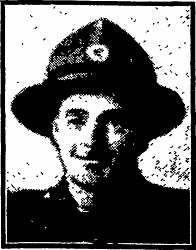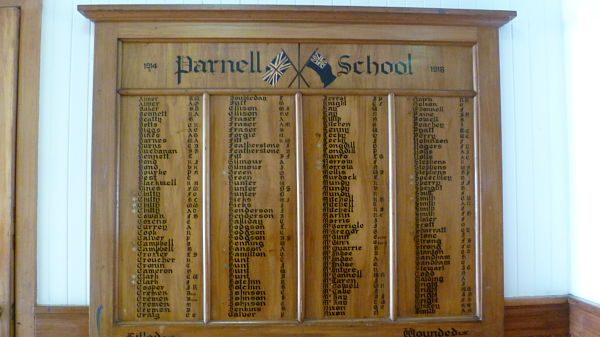WW1 Sergeant Henry Leonard Chitty 12/3583
Henry Leonard Chitty, known as Harry, was born in Dunedin, on 27 September 1886. Henry married Juanita May Munce at her mother’s residence on 16 November 1908.
They lived at 162 Remuera Road, Remuera and had three children; Lavina Daphne Bell (1910), Thelma (1913) and Hazel May (1915). He was a bootmaker with Murray & Co of Cook St, Auckland. Henry enlisted on 27 May 1915 in Auckland and was described as 5ft 7 inches tall, with blue eyes and brown hair. He set sail on 8 January 1916 for Suez, Egypt on HMNZT ‘Maunganui’ as a Private with the 9th Reinforcements, Auckland Infantry battalion, A Company, New Zealand Expeditionary Force He gained promotion to Sergeant on 1 July 1916, whilst he was in Egypt. Shortly after, he was transferred to the Western Front near Rouen, France and was wounded on three occasions.
The first occasion was on 1 September 1916 when he suffered a head wound. He was transferred to England, to Hornchurch then to Codford Hospitals to recuperate until 11 October 1916, when he re-joined his Regiment in Rouen, France. On 3 January 1918, he was admitted to No 18 General Hospital, with severe burns to his hands and face. There was a report of the incident, and a written explanation of the accidental burning of Sergeants Henry Leonard Chitty (12/3583) and Arthur Vincent Alford (13/2995) by Sergeant Norman Walter Buckthought (18758) who stated: On January 1, 1918 at about 4pm, I was sitting around a brazier with Sergeants Chitty, Alford, and Matthews when an explosion occurred, and the room was filled with flames. We all rushed for the door and Sgts Chitty and Alford being last out were burnt on the hands and face. The explosion came from under a bunk near the brazier and was evidently caused by explosives left by previous occupants and unknown to the sergeants. Corroborated by Sergeant Ernest Charles Matthews (12/3417) [1, 2]
On his recovery, Henry re-joined his regiment. He was wounded in action on 23 May 1918 but re-joined his regiment two days later. The third time he was wounded, was on 24 August 1918 with wounds to his head and abdomen [3] He was reported as ‘dangerously ill’ on 26 September 1918, on 29 September 1918, still in a dangerously ill condition becoming weaker, and sadly on 30 September 1918 at 12.15am, died of wounds in 3rd General Hospital, Le Treport, aged 32. Henry Leonard Chitty (12/3583) is buried at Mont Huon Military Cemetery, Le Treport, Seine-Maritime, France VIII. G. 6B. There are memorials to him at Parnell School and All Saints Church in Ponsonby.
The Observer reported: “Died of wounds, Sergeant H. L. Chitty, of Remuera, who, although quite likely very few of them knew it, used to make quite nice footwear for fastidious Aucklanders before he went to war. Harry Chitty left his last, etc. however, to enlist with the Ninth Reinforcements, the crowd who had the shortest training on record, but who made such good fighters when they struck France. Sergeant Chitty was always in the thick of it and managed to stop bullets and shell fragments no less than four times. Ultimately he was made sergeant bootmaker to the Second Auckland Battalion, and his pals thought he was safe to be one of those to come home. His luck changed, however, and he was dangerously injured, ultimately succumbing to his wounds. By the way, Harry Chitty was at one time prominent in athletic circles, being well known on the running tracks of the district.” [5]
Harry’s brother Frank was also killed in action on 15 June 1916 at the Battle of the Somme. Henry’s wife Juanita had also lost her brother Kenneth Ivan Munce of Remuera, who was killed at Ypres in 1917:
MUNCE.-On October 3, killed in action, Kenneth Ivan, dearly-loved son of Ruth Beamish and the late J. M. Munce, loving brother of Mrs. F. G. Fish and Mrs. H. L. Chitty. Remuera: aged 33 years. Sadly missed. He gave his life for all. [4]
Arthur Thomas Chitty (Service number 25/730) was born in Auckland on 19 January 1889 and attended Parnell District School.
When he left school, he worked as a timber machinist working for F. Phipps, Epsom Avenue, Mt Eden, Auckland. He enlisted on 12 October 1915, and sailed on 5 February 1916 to Suez, Egypt on HMNZT ‘Ulimaroa’ as a Rifleman, with the 3rd Battalion, A company, New Zealand Rifle Brigade and on to France. He became ill with a stomach infection and was hospitalised and sent to England. It was diagnosed as a gastric ulcer. Once he recovered, he worked at No.2 New Zealand General Hospital at Walton, England. On 22 June 1917 he was discharged from the Army as no longer physically fit for war service. He was awarded the British War Medal and the Victory Medal. He died in Auckland on 21 September 1952 and is remembered on the Parnell District School Roll of Honour. [6]
Frank Edward Chitty (Service number 12/3524) was born in Auckland on 20 January 1893.
He attended Parnell District School. After leaving school, he worked as a boot maker with Murray and Company in Cook Street, Auckland [7] He was a keen athlete and cricketer, entering into many competitions as a member of the Auckland Athletics Club and the Auckland Cricket Association, with notable mention in the newspapers of the day in cricket [8] and athletics [9] He enlisted and set sail on 13 November 1915 as a Private with the Auckland Infantry Battalion as part of the 8th Reinforcements in France. On 15 September 1916, he was fatally wounded in action in the battle for the Somme. Frank is buried at Caterpillar Valley (New Zealand) Memorial, Caterpillar Valley Cemetery, Longueval, Somme, France. He is remembered on memorials at, All Saints Church, 284 Ponsonby Road, Ponsonby Auckland 1011, and the South Canterbury Roll of Honour, Scroll and Parnell District School First World War Panel.
Walter Winton Chitty (Service number 25/1046) Walter Winton Chitty (25/1046) was born on 6 September 1894 and attended Parnell District School and is remembered on the School Roll of Honour.
After leaving school he worked as a railway cadet, with Railways Auckland. He enlisted and sailed on 5 February 1916 for England as a Rifleman with the 3rd Battalion, Signalling Corps, New Zealand Rifle Brigade. He was sent to Rouen in France in the signalling corps. On 3 January 1918, he was wounded in action with a severe wound to the chest and abdomen and was on the ‘Dangerously ill’ list until he gradually improved by June 1918 when he was able to assist with light duties on the hospital ward at Walton-on-Thames, England. He returned to New Zealand on the ‘Ionic’ on 24 August 1918. He was awarded British War Medal and Victory Medal. He died in Auckland 30 March 1954 [10] He is remembered on the Parnell District School World War One Panel.




